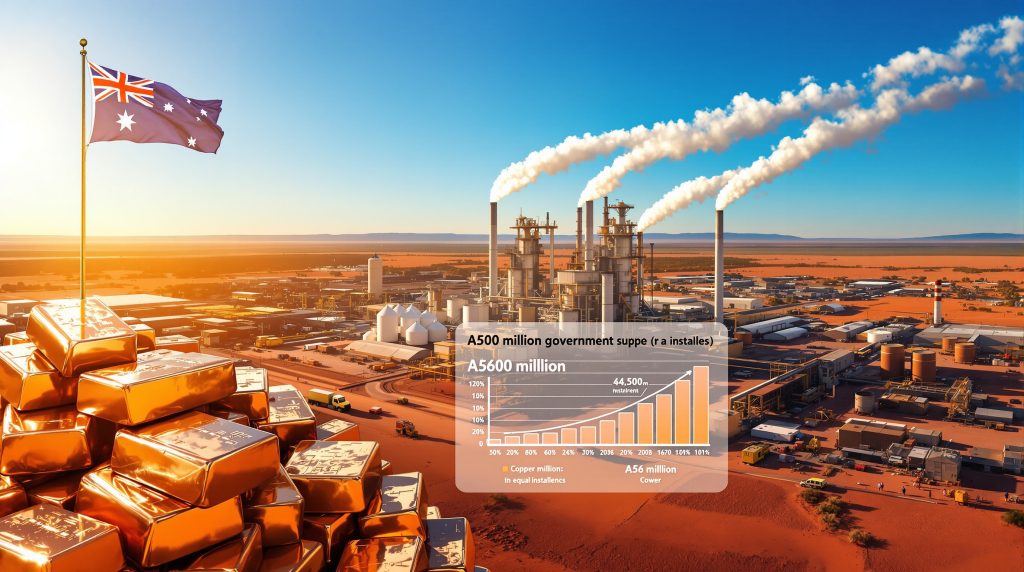Glencore Government Support Package: Securing Australia's Copper Industry Future
How Is the Australian Government Supporting Glencore's Copper Operations?
The Australian and Queensland governments have joined forces in a landmark financial commitment of up to A$600 million (US$395 million) to sustain Glencore's critical copper processing facilities. This strategic funding package specifically targets the Mount Isa copper smelter and Townsville copper refinery, representing a significant vote of confidence in Australia's domestic mineral processing capabilities.
The support mechanism has been carefully structured with fiscal responsibility in mind. The package will be delivered through three installments of up to A$200 million, with each payment contingent upon meeting specific milestones. The first installment requires completion of a comprehensive transformation study examining the entire copper value chain at Mount Isa, while subsequent payments depend on satisfying review benchmarks established by government stakeholders.
Industry Minister Tim Ayres emphasized the dual purpose of this initiative, noting it "protects Mount Isa's workforce while reinforcing Australia's industrial capabilities for renewable energy transition." The minister specifically highlighted copper's essential role in manufacturing solar panels, wind turbines, and energy storage systems—all critical components of Australia's energy future.
For Glencore, this agreement provides crucial breathing room after absorbing significant financial losses to maintain operations. Troy Wilson, Glencore Metals Australia's interim COO, characterized the package as "a short-term lifeline for the copper smelter and refinery" while expressing gratitude to the workforce whose "commitment and resilience over the past eight months has been outstanding."
Why Is Government Support Necessary for Glencore's Copper Operations?
Economic Challenges Facing Copper Processing
The global copper processing landscape has undergone significant disruption in recent years, creating an environment where government intervention has become necessary to preserve strategic industrial capabilities. Several interconnected factors have contributed to this situation.
First, an oversupply of global smelting capacity has fundamentally altered market dynamics. This excess capacity, particularly from rapid expansion in China, has disrupted traditional supply-demand balances and created unsustainable competitive pressures on established facilities.
The resulting market imbalance has driven processing fees to record lows. These treatment and refining charges (TC/RCs) represent a critical revenue stream for smelters, and their depression has severely impacted operational viability for facilities like Mount Isa.
High energy costs have further compounded these challenges. Copper smelting is energy-intensive, and Australia's energy pricing environment has placed additional pressure on operational margins already squeezed by depressed processing fees.
Without government intervention, Glencore had clearly indicated it would transition these vital facilities into care and maintenance mode—effectively shutting down Australia's only remaining copper smelter capable of processing both domestic and regional copper concentrates.
Strategic Importance to Australia's Industrial Base
Beyond immediate economic considerations, the Mount Isa copper smelter represents a critical industrial capability with significant strategic importance for Australia's economic sovereignty.
As the country's only domestic facility processing copper products from both local and regional sources, the Mount Isa smelter provides irreplaceable mineral processing capabilities. This self-sufficiency is particularly valuable given increasing global copper supply forecast vulnerabilities highlighted by recent geopolitical tensions.
The facility also represents an essential component of Australia's critical minerals strategy. Copper's classification as a critical mineral reflects its irreplaceable role in energy transition technologies, defense applications, and advanced manufacturing—sectors where Australia aims to maintain competitive advantages.
Moreover, as a key supplier for renewable energy manufacturing supply chains, the facility directly supports Australia's climate objectives. Maintaining domestic copper processing capabilities ensures Australia can participate in higher-value segments of the renewable technology supply chain, rather than merely exporting raw materials.
What Does the Support Package Include?
Financial Structure and Conditions
The Glencore support package implements a staged funding approach with clearly defined conditions and accountability mechanisms. This structure balances immediate financial relief with longer-term strategic planning requirements.
The initial installment of up to A$200 million is contingent upon Glencore completing a comprehensive transformation study examining the entire copper value chain at Mount Isa. This study will identify operational improvements, technological modernization opportunities, and strategic repositioning options to enhance long-term sustainability.
The second and third installments, each also up to A$200 million, will be released only if Glencore meets specific review milestones established in collaboration with government stakeholders. These progressive evaluations ensure the company demonstrates measurable progress toward financial sustainability before receiving additional funding.
This measured approach provides immediate stability while establishing a framework for long-term viability, representing a more sophisticated intervention than unconditional subsidies. The three-year timeframe allows sufficient runway for implementing strategic transformations while maintaining a clear endpoint for government support.
Glencore's Reciprocal Commitments
In exchange for government support, Glencore has made substantial commitments that extend far beyond merely continuing operations. These reciprocal obligations ensure the public investment generates broader economic benefits.
Most significantly, the company has committed to investing A$2.5 billion in the Mount Isa region over the next six years. This substantial capital injection will fund critical infrastructure, operational improvements, and resource development that strengthens the region's mining ecosystem.
The investment program includes further development of the George Fisher Mine, one of Australia's most significant silver-lead-zinc operations. Additional potential exists for expansion of the Black Star Open Cut project, potentially unlocking additional mineral resources critical to regional prosperity.
Glencore has also committed to maintaining employment and operational continuity throughout the support period, providing job security for hundreds of workers and their families. This workforce stability preserves specialized technical knowledge that would be difficult to reconstitute if operations ceased.
The company's participation in the mandated transformation study represents another significant commitment. This comprehensive assessment will identify pathways to enhance long-term viability through operational improvements, technological modernization, and strategic repositioning within global copper markets.
What Are the Employment and Community Benefits?
Job Protection and Regional Impact
The support package delivers immediate employment stability with far-reaching implications for regional Queensland. Most directly, it secures over 600 positions at the Mount Isa smelter and Townsville refinery—specialized industrial roles that provide above-average incomes and support family livelihoods.
The employment benefits extend beyond Glencore's direct operations. Approximately 500 additional jobs at Dyno Nobel's Phosphate Hill project depend on infrastructure and services shared with Mount Isa's mining operations, demonstrating the interconnected nature of regional industrial ecosystems.
When accounting for indirect employment effects through supply chains, service providers, and consumer spending, thousands of additional jobs throughout regional Queensland rely on the continued operation of these facilities. This employment multiplier effect underscores the support package's broader economic impact.
The regional stability provided by these secure employment opportunities is particularly valuable for communities like Mount Isa, where mining and processing activities form the economic foundation. This stability enables long-term community planning, supports property values, and maintains essential services that might otherwise become unviable.
Industrial Ecosystem Preservation
Beyond direct employment impacts, the support package preserves a complex industrial ecosystem that has developed around these processing facilities over decades. This ecosystem includes specialized supply chains, technical service providers, logistics networks, and educational partnerships that would be difficult to reconstitute if operations ceased.
Many regional businesses have developed specialized capabilities to service the unique requirements of copper processing operations. These businesses form critical supply chains that provide everything from specialized equipment to maintenance services, creating an industrial cluster with significant economic value.
The facilities also maintain repositories of specialized industrial knowledge and technical expertise in mineral processing. This institutional knowledge represents intellectual capital developed over decades that would be permanently lost if operations ceased, potentially compromising Australia's future capabilities in critical minerals processing.
Community infrastructure supported by mining operations forms another vital component of this ecosystem. From educational facilities to healthcare services, many community assets receive direct or indirect support from mining operations, creating an interconnected socioeconomic system.
How Does This Support Package Compare to Other Industry Assistance?
Recent Precedents in Australian Industrial Support
The Glencore support package follows established patterns of strategic government intervention in Australia's metals sector, particularly for regionally significant operations facing structural challenges. This approach balances immediate economic needs with longer-term strategic considerations.
In recent years, Nyrstar received comparable support for its zinc operations, preserving critical processing capabilities while providing regional employment stability. This intervention demonstrated similar strategic logic—maintaining domestic processing capabilities for minerals essential to industrial and renewable technology applications.
The aluminum sector has also seen targeted government support, particularly around energy challenges that threatened smelter viability. These interventions recognized the strategic importance of maintaining domestic aluminum processing capabilities despite global market pressures.
More broadly, Australia has increasingly adopted strategic approaches to critical minerals development, including processing capabilities. This includes various support mechanisms designed to expand domestic mineral beneficiation benefits rather than simply exporting raw materials—a recognition that higher-value activities generate greater economic benefits.
Global Context for Government Support
Australia's approach aligns with emerging international trends in critical minerals policy, where governments increasingly view domestic processing capabilities as strategic assets warranting targeted support. This perspective has gained momentum as countries seek to secure supply chains for energy transition technologies.
The US Inflation Reduction Act represents perhaps the most aggressive example, providing substantial support for domestic critical mineral processing through tax incentives, grants, and procurement preferences. This landmark legislation specifically prioritizes building domestic supply chains for minerals essential to clean energy technologies.
Similarly, the EU Critical Raw Materials Act establishes comprehensive frameworks for developing strategic mineral capabilities, including processing infrastructure. This initiative aims to reduce Europe's dependence on imported materials and processing services for minerals critical to industrial and technological sovereignty.
Canada's Critical Minerals Strategy likewise includes financial support mechanisms for processing infrastructure, demonstrating a similar recognition of these capabilities' strategic importance. This approach parallels Australia's efforts to maintain sovereign processing capabilities despite challenging market conditions.
What Are the Long-Term Implications for Australia's Copper Industry?
Transformation Study Objectives
The mandated transformation study represents a critical component of the support package, looking beyond immediate operational continuity to develop pathways for long-term sustainability. This comprehensive assessment will examine multiple dimensions of the copper value chain at Mount Isa.
Modernization opportunities for processing facilities form a central focus, exploring how technological upgrades could enhance efficiency, reduce costs, and improve product quality. These improvements might include automation, digital monitoring systems, and process optimization technologies that increase operational competitiveness.
Energy efficiency improvements represent another critical study area, addressing a major cost factor for processing operations. Identifying opportunities to reduce energy consumption through equipment upgrades, process modifications, and operational adjustments could significantly improve cost structures.
The integration of renewable energy sources offers additional potential for both cost reduction and environmental performance improvement. Mount Isa's location in Queensland provides access to substantial solar resources that could supplement traditional energy sources, potentially reducing costs while lowering carbon emissions.
Value-added processing opportunities within Australia represent perhaps the most transformative possibility. By identifying higher-value copper products that could be manufactured domestically, the study could develop pathways for Australia to capture more of the copper value chain rather than simply exporting raw or semi-processed materials.
Strategic Alignment with Net Zero Transition
This support package reinforces Australia's position in the global energy transition, recognizing copper's essential role in enabling renewable energy technologies. This strategic alignment creates opportunities for Australia to leverage its mineral resources for greater economic and environmental benefits.
Copper represents an irreplaceable material for renewable energy infrastructure, with applications including solar panels, wind turbines, energy storage systems, and electricity transmission networks. As global demand for these technologies accelerates, copper price insights suggest consumption is projected to increase substantially, creating long-term market opportunities.
Maintaining domestic processing capabilities reduces Australia's supply chain vulnerabilities in critical technology areas. This self-sufficiency becomes increasingly valuable as global competition for processed critical minerals intensifies, providing greater security for downstream manufacturing and renewable energy deployment.
Perhaps most significantly, these processing capabilities create foundations for downstream manufacturing opportunities in renewable technology sectors. By maintaining the ability to process copper domestically, Australia preserves options for higher-value manufacturing activities that could generate substantial economic benefits.
This strategic positioning supports Australia's "Future Made in Australia" industrial strategy, which aims to rebuild domestic manufacturing capabilities in sectors aligned with the country's comparative advantages. Copper processing represents a critical link between Australia's mineral resources and potential manufacturing renaissance.
What Challenges Remain for Glencore's Australian Operations?
Ongoing Market Pressures
Despite the government support package, several fundamental challenges continue to threaten the long-term viability of Glencore's Australian copper operations. These structural issues require comprehensive solutions beyond temporary financial assistance.
Global copper processing overcapacity issues remain unresolved, with continued expansion of smelting capacity creating persistent downward pressure on processing fees. This fundamental market imbalance represents a challenging environment for higher-cost operations like Mount Isa.
Energy costs continue to impact operational competitiveness, despite potential improvements through efficiency measures and renewable integration. Australia's energy pricing environment presents ongoing challenges for energy-intensive processing operations competing against facilities with lower energy costs.
International competition, particularly from Chinese smelters with newer technology and lower operating costs, remains intense. These operations often benefit from various advantages including scale economies, government support, and proximity to manufacturing centers that utilize refined copper.
Long-term viability ultimately requires significant operational transformation beyond the immediate support period. Without fundamental improvements in cost structures, technological capabilities, and market positioning, these operations may face renewed viability challenges once government support concludes.
Transformation Requirements
For sustainable operations beyond the support period, Glencore must implement substantial operational improvements that address fundamental competitiveness challenges. These transformations span multiple operational dimensions.
Energy efficiency improvements represent an essential requirement, given energy's substantial contribution to operating costs. Implementing best-available technologies, process modifications, and operational optimizations could significantly reduce energy consumption per ton of processed copper.
Processing technology upgrades are similarly necessary to improve recovery rates, product quality, and operational efficiency. Modern smelting and refining technologies can achieve higher metal recoveries with lower energy consumption, potentially transforming cost structures.
Supply chain optimization provides additional improvement opportunities, from concentrate sourcing to product distribution. Enhancing logistics efficiency, developing strategic supplier relationships, and optimizing inventory management could deliver meaningful cost reductions.
Market development for Australian-processed copper needs expansion to capture premium pricing opportunities. By identifying and developing relationships with customers who value supply security, environmental performance, or specific quality attributes, Glencore could potentially command price premiums that improve operating margins.
How Will Success Be Measured?
Key Performance Indicators
The effectiveness of the support package will be evaluated through multiple metrics reflecting different stakeholder priorities and timeframes. These indicators provide a framework for assessing whether the investment delivers its intended benefits.
The most immediate measure is the continuation of operations through the support period, maintaining processing capabilities and employment. This basic continuity represents the minimum threshold for success, preserving options for longer-term transformation.
Completion of transformation study recommendations with actionable implementation plans represents another critical milestone. This comprehensive assessment should deliver detailed, prioritized improvement initiatives with clear business cases and implementation roadmaps.
Implementation of operational improvements identified through the transformation study provides evidence of progress toward financial sustainability. Measurable improvements in energy efficiency, processing recovery rates, and production costs would indicate meaningful operational transformation.
Progress toward financial sustainability represents the ultimate objective, with operating margins indicating whether operations can continue without ongoing government support. Positive and improving operating margins would suggest the possibility of sustainable operations post-support.
Maintenance of employment levels throughout the support period and beyond provides another key indicator, reflecting the social and economic benefits that partially justified government intervention. Stable or growing employment would indicate successful preservation of regional economic activity.
Stakeholder Perspectives
Various stakeholders will assess success differently based on their specific priorities and interests, creating a multidimensional evaluation framework.
Government stakeholders will primarily measure success through the preservation of strategic industrial capability and employment. From this perspective, maintaining domestic copper processing capabilities that support renewable energy supply chains while preserving regional jobs would constitute success.
For Glencore, success means establishing a path to sustainable operations and acceptable returns on investment. The company requires sufficient operational improvements to ensure competitive positioning after government support concludes, with attractive long-term economics to justify continued capital investment.
Workers and their representatives will prioritize job security and stable employment conditions. From this perspective, success means not only preserving jobs through the support period but establishing sustainable operations that provide long-term employment security.
Host communities will evaluate success through continued economic activity and regional development. Beyond immediate employment impacts, communities benefit from business activity throughout supply chains, maintained property values, and sustained population levels that support community services.
The broader industry will assess success through maintained domestic processing capability for Australian miners. Domestic smelting and refining capacity provides optionality for concentrate producers, potentially reducing logistics costs and supply chain complexities compared to export-only options.
Securing Australia's Copper Future
The strategic support package for Glencore's copper operations represents a significant commitment to Australia's industrial capabilities and regional prosperity. By preserving critical processing infrastructure while mandating comprehensive transformation planning, this intervention balances immediate needs with longer-term strategic positioning.
For Australia's copper industry, this support provides breathing room to develop sustainable operational models amid challenging global market conditions. The transformation study offers a structured approach to identifying improvement opportunities that could enhance long-term viability beyond the support period.
From a regional perspective, the package delivers immediate stability for communities dependent on these operations, preserving thousands of jobs throughout north Queensland. This employment stability maintains social fabric while providing time for potential economic diversification initiatives.
Most importantly, the support package maintains Australia's strategic positioning in critical mineral value chains essential for the global energy transition. By preserving domestic copper processing capabilities, Australia retains options for participating in higher-value segments of renewable technology supply chains.
The coming years will determine whether this strategic intervention achieves its objectives of transforming operations for long-term sustainability. Success will require collaboration between government, industry, and communities to implement meaningful operational improvements while developing new market opportunities for Australian copper investment and processing capabilities. Meanwhile, the impact on global markets cannot be ignored, as similar challenges affect copper processing worldwide, including the recent Glencore copper smelter impact in Chile.
Ready to Stay Ahead of Major Mineral Discoveries?
Discover actionable opportunities in ASX-listed mining companies before the broader market with Discovery Alert's proprietary Discovery IQ model, which provides real-time alerts on significant mineral discoveries like Glencore's copper developments. Visit the Discovery Alert discoveries page to understand how early identification of major mineral findings can lead to substantial investment returns.




